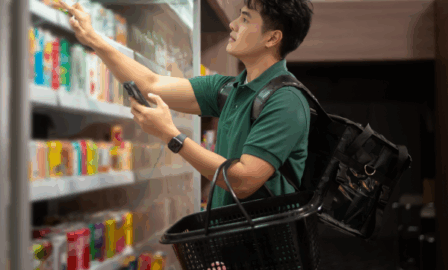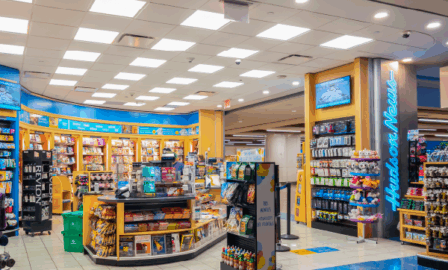From Pit Stop to Destination: The Transformation of Convenience Stores
Convenience stores, or c-stores, were once known as pit stops on a driver’s journey – places to fill up your tank, use the restroom, and grab a quick snack. However, over recent years a significant transformation has started as leading c-stores are repositioning themselves as foodservice destinations and digitally connected retailers.
The Transformation of Convenience Stores
With grocery and restaurant prices climbing, c-stores are seizing the opportunity to differentiate themselves with offerings that combine speed, value, and quality. By leveraging digital tools, food innovation, and AI-powered operations, c-stores are exploring a number of strategies to become more than just a pit stop and compete directly with grocers and quick-service restaurants.
Building Loyalty Through Digital Tools
Loyalty programs and mobile apps are becoming core platforms for engaging shoppers, integrating fuel rewards with in-store experiences, capturing valuable customer data, and converting fuel customers to in-store shoppers.
C-stores can deliver a personalized retail experience that encourages repeat visits by segmenting offers, tailoring promotions, and removing friction from the customer experience. For example, BP’s Earnify app links fuel savings with in-store purchases, while 7-Eleven’s 7Rewards program combines points, digital wallet functionality, and personalized promotions for millions of customers across North America.
Smaller operators are also leaning into digital engagement. Parker’s Kitchen, a regional chain in the Southeast, has built its Parker’s Rewards app to connect fuel, in-store purchases, foodservice, and promotions in one experience – for example, allowing customers to place and pay for food orders while they’re at the pump.
These examples show that innovation in loyalty and digital tools is accessible at any scale, but retailers should be thoughtful in planning their technology investments in this space. IT integration and strong data foundations are essential, but having the associated processes, data governance, and employee training in place will be critical components to delivering the most value to the customers.
Foodservice and Store Format as Differentiators
Innovation in foodservice has become a key driver in turning c-stores into destinations. To compete with restaurants, retailers are expanding menus, testing limited-time offerings, and introducing private label products that drive brand loyalty and margin. For example:
- Wawa has broadened its menu beyond breakfast and lunch to include soups and hot entrées for dinner.
- Casey’s General Stores, already one of the largest pizza chains in the U.S., has expanded into a diverse array of sandwiches and limited-time menus.
- QuikTrip has redefined its store model by creating QT Kitchens, offering made-to-order meals, coffee, and smoothies that rival fast food chains.
- Kwik Trip, a mid-sized Midwest chain, has leveraged its vertically integrated supply chain to grow a private label program in bakery, dairy, and prepared foods as a way to efficiently deliver high quality fresh products to their customers.
Changes to the physical store formats are reinforcing these strategies. Expanded seating areas, digital menu boards, order kiosks, and self-checkouts make c-stores more inviting and operationally efficient. These investments require careful process design and deep understanding of customer preferences and the customer journey.
AI is Accelerating the Transformation
Artificial intelligence has quickly surpassed pilot projects and proof of concepts, to driving real use cases across the enterprise in convenience. Retailers are using AI to optimize hiring, streamline operations, and make smarter pricing and merchandising decisions.
- 7-Eleven’s RITA assistant has reduced store labor hours by automating candidate screening and scheduling.
- Sheetz applies predictive analytics for fuel pricing, noting its benefits in managing prices across various diverse markets with heavy competition
- Circle K has rolled out AI-driven task management, helping store teams prioritize and focus on the highest-value activities while surfacing real-time customer insights from surveys.
Beyond these examples, AI is also being embedded into forecasting, inventory management, and customer engagement. While industry leaders may be pushing the forefront of AI-powered applications in convenience, there are countless opportunities for c-stores of all shapes and sizes to take a crawl-walk-run approach in building their AI foundations and starting their AI journey with high ROI use cases.
The Road Ahead
Convenience stores are evolving from pit stops into destinations by embracing new innovations in personalization, foodservice, and technology-enabled efficiencies. While national leaders set the pace, mid-sized players like Kwik Trip and Parker’s Kitchen demonstrate that innovation is possible at any scale, but the challenge for many c-stores will be deciding where to focus limited resources and how to implement changes effectively.
At Clarkston, we work with retailers to define, plan, and execute on these critical strategies. Whether it’s designing IT roadmaps, leading technology implementations, or optimizing store operations, we help c-stores take the next step on their own transformational journey.
Subscribe to Clarkston's Insights
Contributions from Hannah Yang



